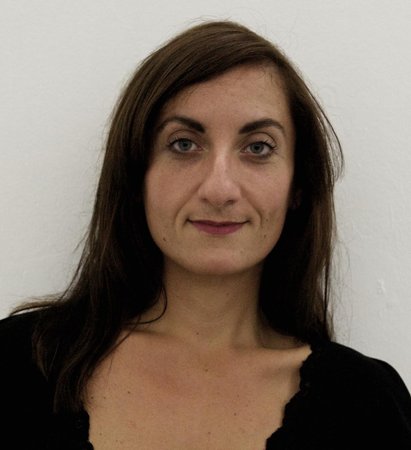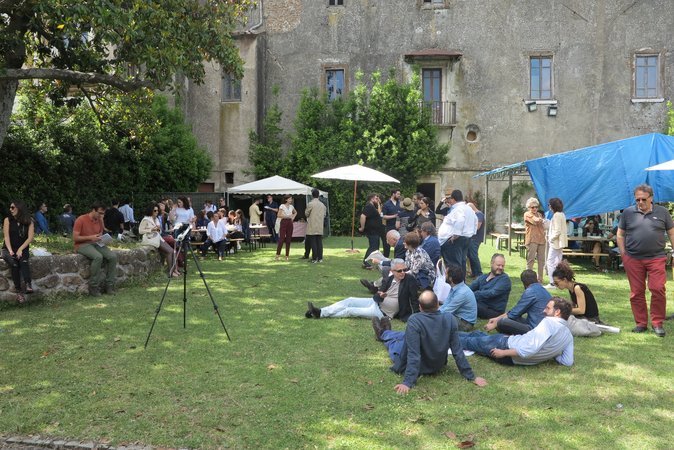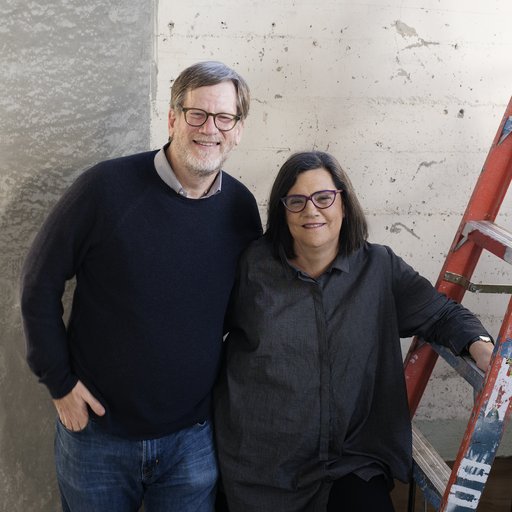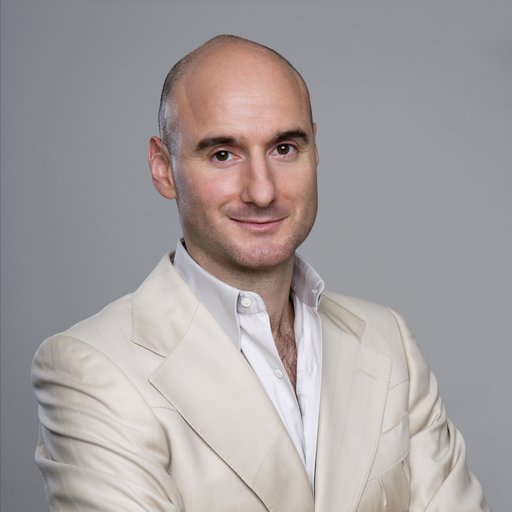Located in the 16th-century Palazzo Rospigliosi in the rustic country village of Zagarolo, a short drive outside of Rome, Granpalazzo is unlike any art fair you’ve seen before. Instead of traditional booths, there are curated presentations of individual artists, elegantly spaced throughout the historic building. The walls are covered with historic frescos, the conversation is amiable, and the pace is as relaxed as the gauzy light filtering through the palms outside. Call it an art fair, Italian style.
 Monitor Gallery's Paola Capata
Monitor Gallery's Paola Capata
A happy anomaly amid the Art Basels of the world, Granpalazzo was launched last year by two Roman dealers, Paola Capata of Monitor Gallery and Federica Schiavo of her own eponymous space, together with the events manager Delfo Durante and curator Ilaria Gianni, who organizes the presentation.
Capata, who opened her gallery in 2003, sees it as a corrective to an art market that has tilted its emphasis too heavily on the “market,” and away from the “art.” For her, it’s a banner in a cause worth fighting for.
To understand more about what, exactly, Granpalazzo is, Artspace editor-in-chief Andrew M. Goldstein spoke to the dealer about the ideas behind her unorthodox fair.
Tell me, how did this project get started? It’s such an unusual art fair. Where did you and your co-founders get the idea?
We were thinking about all the art fairs that we are all doing all the time, which are very expensive in terms of money but also time and resources. Right now we do seven, eight a year, and before there were years where Monitor was doing 12 fairs. So it’s quite demanding, especially for a young gallery, but all the young galleries are trying to get into major art fairs because they open you to new and bigger markets and give you visibility, and also because art fairs have become the trend of the moment. Now, when you meet people, they don’t ask you which artists you represent, they ask you which fairs are you doing—which is quite significant, you know?
Unfortunately, this put everybody in a loop where you only look at the main art fairs like Frieze, FIAC, Art Basel, or Liste, where you struggle to get in because they demand a lot—they look at your gallery profile, the artists that you represent, and the kind of work you’re doing in your own country, which is also really important. So, thinking about all of this, we came to the conclusion that we would like to do something different that is not against this big art fair market, because that’s important, but that is a totally new thing.
So, for one, it’s a small project that is going to stay small. We don’t want to have 50 galleries in a few years—we’re not interested in that. If you look at the roster of the galleries we invited to the first edition, for example, almost all of them were people we know really well, like colleagues that I have shared booths with at other fairs over the years. This year, for example, we invited Ellen de Bruijne, who is someone I’ve known for 10 years—we’ve been together in the same room in Liste for four years, and we shared a booth in Artissima.
The only reason why the number of the galleries has doubled compared to last year is because we wanted to have more things to see for the two-day duration of the fair, and also because our network of friends and galleries has grown because of all the new contacts that we get during the year. What we did was call these people, whose programs and missions we admire, and say, “Look, what we’re doing is a small project, and we’re trying to do it really nicely and well. We would like you to come with us to experiment in a different approach to meeting collectors, curators, and, of course, colleagues, too.”
Because, most of the time, Granpalazzo is really about networking. That’s the key word, and a lot of things happened after the first edition: galleries met new clients and sold to new clients, which was great for the first edition, but they also got in touch with each other and are now talking about sharing artists. Or, for example, Monitor just shared a temporary pop-up space in Milan with P420 from Bologna and SpazioA from Pistoia, and that only happened because of the relationship we had from Granpalazzo.
 All photos show views of Granpalazzo's inaugural edition in 2015
All photos show views of Granpalazzo's inaugural edition in 2015
One element that sets your fair apart is its unorthodox setting, in a country palazzo outside Rome. Typically, fair organizers try to site their events in the center of economic hubs. What are the advantages of being in Zagarolo?
The thing is, Zagarolo is a very small village in the countryside, about 40 minutes from Rome, and it’s kind of wild in a way. It’s not something pretty and cozy like a village in Umbria, for example. It’s in the middle of nature, which is really powerful and immediately puts you in a different kind of context. It’s not chic, it’s not luxury—it’s just different. It’s a place where you don’t expect to find a lot of anything, so, in the end, when you discover so much more than you were expecting it’s very exciting.
That’s something we considered, and we wanted to do something that wasn’t in Rome. Because Rome is close enough to be a lure for collectors to come anyway—they can also go to Rome if they want to. If you’re a collector and want to stay for more than Granpalazzo it’s easy to take a few days in Rome. In fact, last year a few collectors came a couple of days before and stayed in Rome to visit the galleries. This year, a lot of the galleries are opening the week before the fair, too, so we’ve put things together in a way that there will be plenty to see in the city.
How do you ensure that you can bring top collectors to the fair when it’s outside the city?
The collectors that we invite like the VIP program, they stay in Zagarolo. So, normally, last year they stayed in Zagarolo for two days, Saturday and Sunday. They normally leave on Sunday afternoon.
Well, we have a VIP program like any other fair, so basically we invite them as our guests to stay for two days, providing them with hotels and dinners that we organize in Zagarolo. The thing is, the collectors also want to be close to curators as well, so part of the VIP program into also include curators. Last year, for example, we brought in Florence Derieux, who is now in New York as the curator-at-large for the Centre Pompidou, and Andrea Viliani, the director of the Madre Museum. These people, they don’t all live in Rome, and that’s just the reality.
So, you invite these people to an amazing 16th-century palazzo in the countryside, you put them up in hotels, and you give them nice dinners so that they can come and see the artworks on display and make new connections. That sounds more like a conference or retreat like Davos rather than your typical art fair, which is really a trade show, pure and simple. Is that the way you think about it?
Yeah, exactly. Also, because the palazzo itself is not so big, you can definitely enjoy it in a couple of hours if you go fast—but we don’t want you to go fast. We want you to slow down, actually, and spend more and more time inside so you finally start to talk with people. It’s not just about going to a booth and saying, “Ah, I like this, this, and that.” It’s more about conversation and engagement.
For example, Art Basel is a few weeks after Granpalazzo, and last year I heard that dealers who had started relationships with collectors at Granpalazzo were able to see them again in Basel, which opened up more dialogue. And everybody you meet at Granpalazzo is going to remember you, because it’s such a particular context, you know? Sometimes, I meet people and they say, “Oh, you were at Frieze,” and I say, “Well, I don’t do Frieze, so who knows where you met me.” Being together at Granpalazzo is not something you forget so easily.

I can see how that kind of setting can be great for networking and creating real relationships, but does it also really work for sales? How do you square the social aspects with the market imperatives?
The thing is, Granpalazzo works as an exhibition, basically. A lot of artists in fact list Granpalazzo as a show on their CV, which is nice, because that’s the way they experience it thanks to our curator, Ilaria Gianni. The collectors, however, immediately understand that these artworks are for sale, because, first of all, we prepare them all by saying, “Look, it feels like a show, but in fact it’s a fair.”
You may have noticed that Granpalazzo is just Granpalazzo—it’s not the Granpalazzo Art Fair or the Granpalazzo Show. It doesn’t need to be, because collectors get it. Also, another thing we have that sets Granpalazzo apart is the Premio Claudio, which is a prize given to an artist by a really good Roman collector, Ettore Alloggia. There’s a selection committee, and then Ettore selects the winner.
It seems you’re trying to make it into a prestigious event.
Well, “prestigious” is a big word for an Italian person, but we try to make it special. Our first goal is for our collectors to be happy. I had one of them last year who said, “Oh, it’s a treat. It’s not like a show, it’s not like an art fair, it’s more like a treatment. I’m here, I’m happy, I’m enjoying it.”
You mean like a spa?
Yeah, it’s like a spa. In fact, another thing that’s really important is that we install all the works. At all other fairs, our colleagues have to come a couple of days early and install their booths, so they’re full of stress and aggravation when the fair opens. For myself, I know we spend a day to install and we get mad. At Granpalazzo, the galleries don’t have to.
They sent us all the instructions for installing the works, and then we produce technical solutions to do it because it’s an ancient building with frescoes, so we can’t use nails or touch the walls. Instead, to put the canvas against the wall, we build a really nice, simple, and almost invisible supports to show the canvas right next to the wall.
So, this is something we want to give to our colleagues—a place where they don’t have to get mad at things. They arrive and go to the opening and that’s it. Of course, we’re in constant touch with them about the display, saying, “Hey, look, we can do this, this, and that—what do you think? Do you approve?” Last year was like this, and this year will be the same.

Dealers must love that.
If you look at the roster of the galleries this year, everyone from our first year has returned apart from three people, for several reasons. The two Dutch galleries, for example, aren’t coming back because there’s another art fair in Amsterdam at the same time—but we have two other dealers coming from Amsterdam this year, with one of them saying, "I'd like to do something different for once."
It helps that we have really good people who are bringing good artists they want to highlight. For example, Jan Mot’s Mario Garcia Torres, who is a phenomenal artist, is going to create a new piece for Granpalazzo, which is another interesting step for us. In fact, most of the artists this year have actually created works for Granpalazzo, as far as I know.
That’s interesting, because that’s another touch that makes Granpalazzo less of a sales-focused event, since site-specific work can be a tough sell. Since it’s so exhibition-oriented, I imagine the galleries that come there are not entirely disappointed if they don’t sell everything, because they get the exposure and connections. Are there other similar fairs that you looked to as examples?
Honestly, we weren’t really inspired by anything else. Maybe the only fair that I’m still looking at for inspiration is Liste because of the feeling that you have when you go there, the way they make things look easy and fresh and cool but also dense at the same time. I’ve been a part of Liste for now 10 years, so I’m kind of a veteran, but every time it’s a different thing, with a different feeling. That’s why I like it, and that’s something I want to bring to Granpalazzo.
Tell me about the collectors who come for the fair. Where are they from?
Well, it depends. Considering that each gallery can invite one VIP means, if you have a lot of international galleries you’re going to have international VIPs. It also happens that an Italian gallery will have international VIPs. The way we think of it is that we have 28 artists supported by 28 galleries, which is already a different kind of flavor, and this year we have 10 Italian artists and then 18 artists and galleries that are international.
The collectors who are coming are, I would say, half and half—half Italian and half international. It’s a good mix, I think. We have some driving from Rome, then others from Milan, Sicily, and Naples, and then some from Paris, Belgium, the Netherlands, Spain. Some of our international VIPs from last year are going to come back, and so we have about 105 VIPs total.
It’s a lot, and that’s because Federica and I have our own galleries with our own VIPs, so we get them to come too.We also have at least two private foundations that are coming, VOLUME! and Nomas, which are based in Rome.
At a time when the pace of art fairs is quickening globally, with the tentpole events becoming frenetic multi-industry circuses of efficient dealmaking, Granpalazzo sounds much more laid-back, hospitable, business-agnostic, even hedonistic. In other words, it sounds very Italian.
I like to think so too. It’s really because we’re not doing this as a business. I mean, of course we’ll try—we do take business into consideration—but now Granpalazzo is more like a political act for me.
What do you mean by that?
Well, it means: we can do it. Of course you need money to run a fair or a gallery and make things happen, but we can also find the right way to do it without people getting so agitated all the time. I think that’s something we should consider after so many years of more and more anxiety.
The stress of doing business in the modern world.
Also, it’s really great to have a gallery and to do five or six shows a year—it’s important—but I think as gallerists we should start to do something different, too. We should open up to new situations that pay back in terms of networking and, let’s say, working friendships—which are about work, but still—because they allow you to get close to people in a real way, which is not what happens most of the time.
I hope that when our colleagues leave Granpalazzo, the’ll say, “It was a really good experience to be here.” That’s the idea—that’s the feeling that I want people to have. It’s important that the collectors and clients go away saying, “I was happy.” But, for me, honestly, it’s more important that my colleagues are happy.
How many people do you expect to come to the fair in total?
Not that many. The people at our front desk told us there were 3,000 people over the two days last year, and that’s not a lot if you think that FIAC does 74,000 people—but of course we don’t want that, because that would be a drama. For me, if we have 500 people, it’s fine. It’s an awesome building with tiny rooms and frescoes, so you have to be careful about everything—it’s not like a white cube someplace. It’s something that you have to preserve—you have to preserve the building, you have to preserve the artworks, and you have to preserve the people inside. With the number of people who we’ve already invited, we’ll be okay.
Since Granpalazzo is one of the most exciting alternative fairs in Italy, let’s talk a bit about the Italian art scene. Here’s the time-honored question: When most people think about Italian art, they think about antiquity, the Renaissance, the Surrealists, the Futurists, and Arte Povera. When it comes to the present day, aside from a small handful of big names, the contemporary art landscape in the country is fairly indistinct. Why is that?
So, I have my theory, but it’s not going to be nice.
Go ahead.
I think the main problem for Italian artists, especially the young Italian artists, is that it’s difficult to recognize them in the market. If you look at artists like Maurizio Cattelan and Vanessa Beecroft, for example, who are probably now the most popular artists we have out of Italy, you can recognize their work. I don’t want to say “easily,” but if you see their work, there are elements you can always recognize.
There’s a brand.
Yeah. Then, if you look at the Arte Povera people, even there it’s sometimes difficult to recognize their works apart from the with most important and recognizable artists. Of course, I’m not talking about Mario Merz’s Igloo—you could recognize those anywhere. But with most artists, especially the younger ones, it’s very difficult—and that’s a shame because they’re actually really interesting artists, honestly, in terms of the way they think, the way they work. Sometimes they’re more interesting than more famous artists from other countries.
The problem is that their works look so different from one to the next, which can be something really powerful, of course, but it takes so much longer before the work finds its way. I hate to say this, though, because at the same time I would be skeptical if I went to an artist’s studio and I saw 20 paintings that were all the same.
It’s funny, because in America, especially recently, that kind of branded production has been par for the course.
That’s why I don’t really work with young American artists, most of the time.
Why are American artists so much more conscious of their “brand,” and the strategic usefulness of creating a recognizable style and making enough of it to create a market? Why is that something that comes so naturally to Americans, or the Brits, or so many other artists, while in Italy it hasn’t really taken root?
Well, Italian artists just don’t really think about branding. They like to experiment and try different things. So, this is really good. When I find a young Italian artist who is conscious about the world around him and the art of the past and has a vision of how to finalize his work, that’s probably a really good artist who is going to stay around. But it’s a longer process.
On the other hand, there are a lot of young American artists who are really big on the market for the first three, four years and then they completely disappear. In Italy, if you have one hundred artists there may be five good ones, but those five are going to mature more slowly and stay longer. It’s an ongoing process. It’s just a different kind of aesthetic.
If there is anything that you could change about the Italian art scene, what would it be?
What artists here need are proper schools. They don’t have proper schools. If you go to Goldsmiths, for example, or Bard in the United States, they teach you how to present yourself, and they try to make you understand that it’s a job. It’s a passion, but it’s a job. Here, it’s not like that. You don’t have big names coming to teach at the Academy of Fine Arts in Rome—you have artists who might be really good at technique, but they don’t have a proper CV and they don’t show abroad that much, or even in Italy. So, that’s the lack we have in this country. The schools are not good enough.
What about collectors? Are there many art collectors in Rome? It doesn’t seem to be a place filled with industries that breed young, cultivated people who have money to burn. What is the collector situation like in Rome? Are there new collectors being made all the time? Where are these people coming from and what is the health of the collector landscape there?
Well, there are not so many collectors in Rome. I was lucky enough that I grew up with collectors who aren’t alive anymore but who were outsize personalities who amassed big collections over the years—you could smell the art as soon as you entered the house. Now, you don’t have those personalities so much anymore, especially in Rome. Of course, you have a number of people who are really good, and some of them are also active in the life of the city. But over the past few years, especially, we’ve had many young collectors coming to the gallery, so looked at them and tried to figure out what kind of collectors they could become, or what they might do.
Because we’re not interested in selling art just to sell art. I don’t want to sell something to someone who is going to return after two years and ask if they can put up for auction or sell it back. Honestly, for me, it’s a waste of time—there are galleries that do it, but I don’t. So, basically, we’re always trying to understand if a collector is serious—if they’re committed to the art and want to know more and be engaged—or if it’s just like a trend. If it’s just about a trend, then we try to not interact that much. And, in the past years, we’ve had a lot of young people approaching because it’s a trend.
Why do you think those older connoisseur collectors have dwindled while the trendy people have become ascendent?
Probably because we have Instagram all the time, we have Facebook all the time, we have plenty of websites that are promoting art for sale like Artspace does, and so there’s a lot of information going around. Now there’s a new process that started over the past few years where you post an artwork on Instagram and you know the friends who are following you are going to see it and things become very trendy.
This is very different compared to the moment when I opened the gallery. In any case, all of these things help new people approach art. We just want to understand if they’re going to stay, or if it’s just the moment. Because sometimes that happens, and I’ve seen it before—you have a big wave of people who buy art and then disappear. One day they want to invest in art, the next day they want out. I think that’s going to happen again right now.
Your gallery and Granpalazzo seem to share a sensibility that cuts against this grain, and foregrounds the appreciation of art over the business.No part of you wants to cash in on the hype?
Well, maybe I’m totally wrong, but it’s just something I can’t do. I can’t force myself to do something that I don’t like. Basically, running a gallery is a private thing. Now it’s becoming something different, but I still think it’s an expression of the taste of the gallerist. It’s very easy to follow the trend, but if you don’t believe in the trend you can’t follow it. For me, I could never show something that I don’t appreciate, because I couldn’t sell it, honestly. I couldn’t tell you to buy it because I don’t believe you should buy it. I would not buy it, so why should you.
Maybe I’m not a great dealer, but if I’m doing what I like and it’s fine for me, it should be fine for you, too. I can defend it better. And I just have to make enough money to keep the thing rolling, and to have a salary for myself, my gallery, and my artists. With my artists, it’s not a problem if you they don’t sell now. Maybe they’ll sell in 10 years—that sometimes happens, that artists don’t sell for ages and then suddenly everybody wants that artist. That’s the art market.
You must sleep very well at night.
For the past few years, yes, honestly. I mean, after the first 10 years I lost that kind of aggressive approach that most people have, because it’s easier this way. It’s the same with Granpalazzo. Federica and I don’t show in Granpalazzo, and everybody asks us why. Well, if I showed in the fair, then I’d have to sell my stuff and promote my stuff, not your stuff. Now, instead, I can just focus on putting galleries in touch with other people, and doing what I can for them. It makes you more free.


























